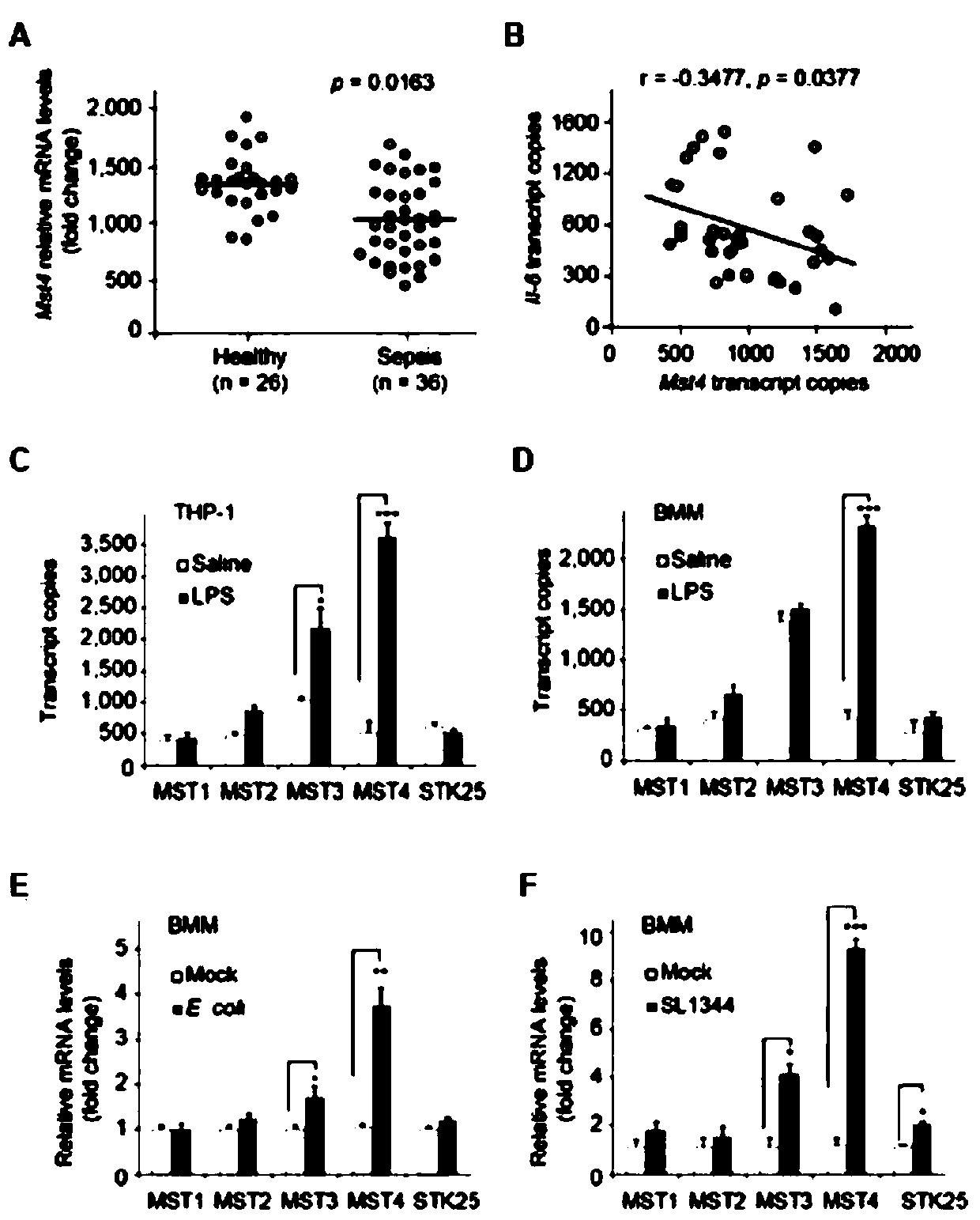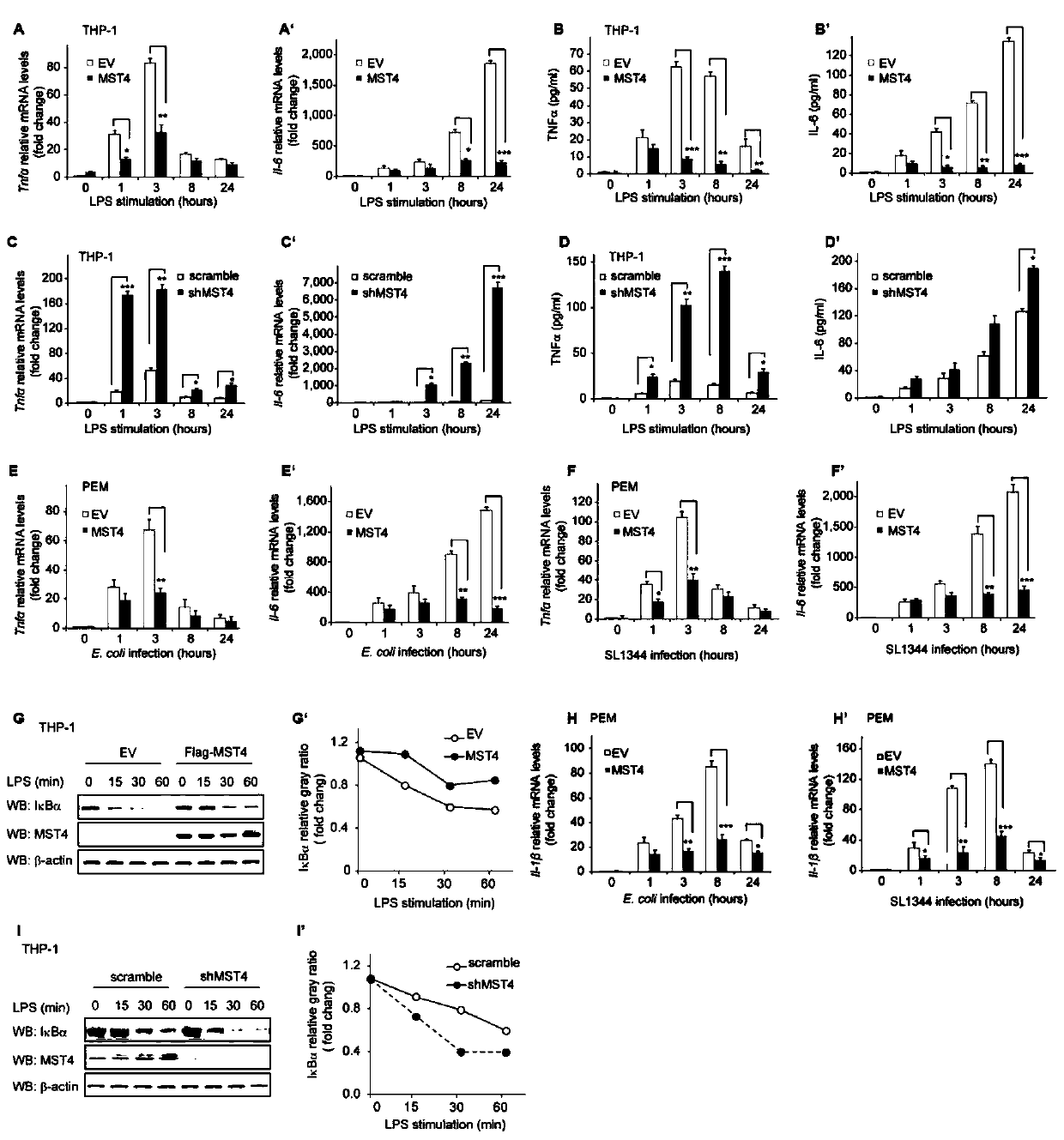Application of mst4 gene diagnosis and cell therapy for infectious diseases and related drugs
A therapeutic drug, MST4 technology, applied in the field of infectious diseases, can solve the problems such as the poor understanding of MST4 biological functions
- Summary
- Abstract
- Description
- Claims
- Application Information
AI Technical Summary
Problems solved by technology
Method used
Image
Examples
Embodiment 1
[0139] The relationship between embodiment 1MST4 expression and bacterial infection
[0140] 1. Purpose of the experiment
[0141] The purpose of this example is to study the correlation between the MST4 gene and MST family homologous genes and bacterial infection.
[0142] 2. Experimental method
[0143] 2.1 Detection of gene expression levels in human monocyte THP-1 and mouse bone marrow-derived macrophage BMM cells
[0144] The method for extracting total RNA from THP-1 nuclei and BMM cells is as described in Basic Experimental Method 12. AMV reverse transcriptase synthesizes the first strand, and uses it as a template to perform PCR amplification with corresponding primers under the action of DNA taq enzyme; See Table 1 for THP-1 cell sample amplification PCR primers, BMM cell sample amplification PCR primers in Table 2, reverse transcription system in Table 3, reverse transcription reaction program in Table 4, Realtime-PCR reaction system in Table 5, Realtime -See Tabl...
Embodiment 2
[0166] Example 2 Changes in the expression level of MST4 after bacterial infection
[0167] 1. Purpose of the experiment
[0168] The purpose of this example is to study the effect of the expression level of MST4 on the expression level of inflammatory cytokines after bacterial infection, and the change of the expression level of MST4 in immune-related tissues or cells.
[0169] 2. Experimental method
[0170] 2.1 Detection of gene expression levels in THP-1 cells after LPS stimulation
[0171] The method for extracting total RNA is as described in Basic Experimental Method 12, and the method for sample amplification and detection is as described in Example 1. The PCR primers for MST4 gene amplification are shown in Table 1, and the PCR primers for TNFα and IL-6 amplification are shown in Table 7.
[0172] Table 7 Primer sequences
[0173]
[0174] 2.2 The experimental method for the detection of gene expression levels in mouse arterial vascular epithelial cells (AVEC),...
Embodiment 3
[0183] Example 3 MST4 negatively regulates the TLR signaling pathway induced by LPS or bacteria
[0184] 1. Purpose of the experiment
[0185] The purpose of this example is to study the effect of MST4 on the expression of immune-related pro-inflammatory cytokines and the regulation of signaling pathways.
[0186] 2. Experimental method
[0187] 2.1 Preparation of lentiviral recombinant shMST4
[0188] Design a 21-base target sequence (shRNA) to knock out the coding region and non-coding region of MST4 respectively. This sequence can form a reverse complementary hairpin-like structure and silence the expression of related genes. MST4 shRNA and control shRNA (scramble) were connected to the lentiviral vector pLKO.1-puro. shRNA (scramble) was used as a control.
[0189] Human shMST4oligo-1 (targets MST4 coding region)
[0190] f
[0191] 5'-CCGGCAGCAAGTCGTTGCTATTAAAATCTCGAGATTTTAATAGCTTCGACTTGCTGTTTTTG-3' (SEQ ID NO: 63)
[0192] R
[0193] 5'-AATTCAAAAACAGCAAGTCGTTGCTAT...
PUM
 Login to View More
Login to View More Abstract
Description
Claims
Application Information
 Login to View More
Login to View More - R&D
- Intellectual Property
- Life Sciences
- Materials
- Tech Scout
- Unparalleled Data Quality
- Higher Quality Content
- 60% Fewer Hallucinations
Browse by: Latest US Patents, China's latest patents, Technical Efficacy Thesaurus, Application Domain, Technology Topic, Popular Technical Reports.
© 2025 PatSnap. All rights reserved.Legal|Privacy policy|Modern Slavery Act Transparency Statement|Sitemap|About US| Contact US: help@patsnap.com



